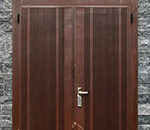The free flowing energetic movements of a dancer can be enchanting to watch. But when it comes to photographing the same it can be a real nightmare. For one thing, you can use a flash/strobe to freeze the movement but that free-flowing hint of movement is never easy to capture with a blinding, instantaneous light. You need a special setup to capture that. In this informative video, photographer Urs Recher demonstrates how he captures both the hint of movement and then freezes the dancer for a sharp image:
Recher uses two lights for this shoot. One is the HMI 400 W continuous light that is fired from the back of the dancer. The light is carefully set up so that there is no spilling on to the floor or the ceiling of the studio. The best thing about this light is that it is daylight balanced. That means it mixes well with the flash that fires toward the end of the exposure.

The HMI lighting up the dancer from behind
The only problem with the HMI is that it can be set to either full or half power. As Recher states,
“This is may be the light that limits me a little bit more.”
The other light is a Siros that’s placed inside a Para 133. The light is set to around 1/4000 of a second to ensure a sharp image.

The Siros light inside a Para 133
The reason Recher uses two lights—a strobe and a continuous light—iis so that he can both freeze the movement as well as capture it. Recher used an exposure setting of around ¼ to ½ second while also using the rear-curtain sync technique. This allows him to capture the flowing movement of the dancer and then freeze her at the end of the exposure. Additionally, the mirror is locked-up to avoid any delay.
The shot was made possible using manual focusing and the pre-focusing technique. Recher asked the dancer to stand at the precise spot where she would be in the final shot to pre-focus. The exposure would be triggered even before the dancer is in the frame. She would move into the precise pre-focused spot at the moment when the Siros light fires. Everything is thus carefully practiced and timed.

Recher manually pre-focusing for the shot
This technique is perfect works very well for times when you want to show motion without blurring the entire image.
Like This Article?
Don't Miss The Next One!
Join over 100,000 photographers of all experience levels who receive our free photography tips and articles to stay current:







Leave a Reply